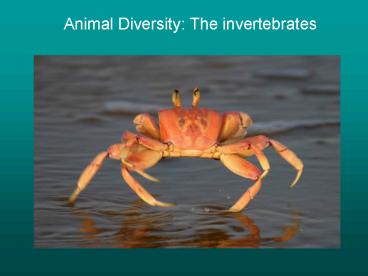Animal Diversity: The invertebrates
1 / 70
Title: Animal Diversity: The invertebrates
1
Animal Diversity The invertebrates
2
Major Animal Phyla
Phylogeny of animal phyla based on DNA sequence
data
3
Relative numbers animal species
4
Types of animal symmetry
5
Animal taxonomy based on presence or absence of
coelom (true body cavity)
6
Herbivore
Carnivore
Omnivore
7
Other feeding strategies
Basking sharks are suspension feeders
Earthworms are deposit feeders they eat decaying
organic matter
Gill rakers used to strain plankton from water
8
Animal Phyla
- Porifera
- Cnidaria
- Platyhelminthes
- Nematoda
- Annelida
- Arthropoda
- Echinodermata
- Chordata
Invertebrates
Includes vertebrates
9
Phylum Porifera, the sponges
- Approximately 5,000 marine spp., and about 150
freshwater spp. - No plane of symmetry, body shapes subject to
change by waves, water currents
10
- Sponge anatomy
Collar cell
Epithelium
Spicule
Pore
Spongin fibers are comparable to collagen fibers
of mammals
Spongin fiber
11
Phylum Cnidaria
Cnidarians have radial symmetry
12
Two general Body Forms of Cnidarians
Bell shaped
Cylindrical
13
Some Cnidarians are either a polyp or a medusa,
and some alternate between medusa stage and polyp
stage
Another example of budding
Lifecycle of Aurelia
14
Compass jellyfish
15
Hydra sp.
16
Sea anemones and corals are also polyps
17
Cnidarians have true tissue layers but no organs
Mouth
Gastrodermis
Mesoglea
Tentacles
Epidermis
Sensory cell
Discharged nematocyst
Undischarged nematocyst
Hydra
Trigger
Stinging cell (cnidocyte) with nematocyst
Filament
Cnidarians capture prey using specialized
stinging cells called nematocysts
18
Phylum Platyhelminthes, the flatworms
There are generally three types of flatworms
Tapeworms
Turbellarians
Flukes
19
Turbellarians are free-living flatworms
The muscles allow complex movements
20
Monogenean flukes are primarily ectoparasites of
fishes
21
Life cycle of Chinese Liver Fluke
Digenean fluke are endoparasites of animals
22
Tapeworms are parasites of the intestine
23
Lifecycle of the pork tapeworm
24
How do flatworms infect animals?
- Endoparasites must be consumed animals and
people ingest an infecting larva stage - Larva becomes an adult via metamorphosis
- Ectoparasite larvae swim to animals and attach to
skin
25
Phylum Nematoda
The vinegar eel is a small free living nematode
Free-living nematodes are important to the soil
by breaking it up, eating bacteria, plants, fungi
and helping to recycle nutrients
26
Generalized Nematode Body Plan
Nematode Anatomy
Nematodes feature a complete digestive tract
27
The amazing journey of Ascaris lumbricoides
28
Lymphatic filariasis
29
Phylum Mollusca
- Many are bilaterally symmetrical
- Possess a true body cavity known as a coelom
- Use an open circulatory system, organs bathed
directly in blood - Body covered by thick sheet of skin (like a
cuticle), mantle cavity houses organs - Shell glands of mantle secrete calcium based
shell - Well-defined muscular foot, often with a
flattened creeping sole
30
General Body Forms of Mollusks
31
Mollusks are important to humanity for many
reasons
As a food source
As a source of disease
Shipworms destroy wooden boats
As a source of art and entertainment
32
Some mollusks use a scraping organ (a radula) to
feed
A chiton
Rasping teeth of a radula
33
Gastropod snails feature a coiled shell
34
Bivalves feature a hinged shell
35
Bivalves use the foot to settle into soft bottoms
water flow
36
Cephalopods
squids
cuttlefishes
octopuses
nautiluses
37
Some mollusks are very large
Architeuthis sp. (Giant squid)
Squid beaks are sometimes found in the stomachs
of sperm whales
38
Phylum Annelida
Feather duster worm
39
Earthworm anatomy
Earthworms have a complete circulatory system,
complete digestive system
Each segment has small hair-like structures
called setae
40
A
B
C
D
Earthworms use hydrostatic locomotion similar to
the movement patterns of flatworms and nematodes
E
Circular muscles squeeze body segments, and
longitudinal muscles pull body segments
41
Some Annelids have parapodia (fleshy appendages
with bristles)
This crawling mechanism is not seen in any other
worms
42
Polycheates
Hydrothermal vent worms
- Worms absorb CO2 and H2S and transport it
through the blood to symbiotic bacteria in its
gut - Bacteria use these chemicals to build
- organic matter which is used by the worm
- This is a symbiotic relationship called a
mutualism
43
Earthworm Mating and Cocoon Production
44
Leeches are hirudineans ectoparasites of other
animals
45
Phylum Arhtropoda
Arthropods have an exoskeleton and jointed
appendages they must periodically molt their
exoskeleton to grow
Dog-day cicada
46
Arthropoda is the largest of all animal phyla
47
Chelicerates vs. Mandibulates
48
General body plan of an insect
Insects have three main body segments and
three pairs of walking appendages
49
Some Arthropods have compound eyes
Light sensing organ
50
How are compound eyes different from human eyes?
Compound eye
Camera eye
- One large lens
- Low degree of peripheral vision
- Can see far distances
- Many small lenses
- High degree of peripheral vision
- Cannot see far distances
51
(No Transcript)
52
This is an important feature of terrestrial
arthropods
53
General Body Plan of Arachnids
Arachnids have two main body segments and four
pairs of walking appendages
54
(No Transcript)
55
Spiders (Chelicerata)
Black widow
Brown recluse
Progressive lesion from brown recluse bite
56
(No Transcript)
57
Biramous (left) vs. Uniramous (right) Arthropod
Legs
Gills
58
Carapace
General body plan of a crustacean cephalon (head)
and thorax often fused forming a cephalothorax
59
Japanese giant spider crab crabby tough guy
Tough guy
Giant crab
Look Mommy, I peed my pants!
60
Copepods are important members of many aquatic
communities
61
Centipedes
Millipedes
62
Insects
63
Phylum Echinodermata
64
Starfish anatomy
65
ossicles
66
tube feet
67
(No Transcript)
68
Feather stars and sea lillies
69
Sea urchin
70
Sea cucumbers
Tentacles
Tube feet

